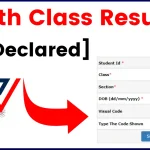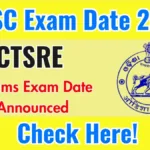Preparing for the 10th board exams is a crucial step in a student’s academic journey. Understanding the syllabus is the first and most important part of this process. Here, a detailed guide on the syllabus for the 10th prelims 2022 is presented, along with commonly asked questions and their answers across various subjects to help students in their preparation.
Top 10th Prelims Syllabus 2022 Question With Answer
Mathematics
Question: What is the formula for the area of a circle?
Answer: The area of a circle is given by the formula A=πr2A = \pi r^2, where rr is the radius of the circle.
Question: What is the quadratic formula?
Answer: The quadratic formula is x=−b±b2−4ac2ax = \frac{-b \pm \sqrt{b^2 – 4ac}}{2a}.
Question: What is the Pythagorean Theorem?
Answer: The Pythagorean Theorem states that in a right triangle, a2+b2=c2a^2 + b^2 = c^2, where cc is the hypotenuse.
Question: How do you calculate the perimeter of a rectangle?
Answer: The perimeter of a rectangle is calculated as 2(l+w)2(l + w), where ll is the length and ww is the width.
Question: What is the slope-intercept form of a linear equation?
Answer: The slope-intercept form of a linear equation is y=mx+by = mx + b, where mm is the slope and bb is the y-intercept.
Question: What is the value of π\pi?
Answer: The value of π\pi is approximately 3.14159.
Question: What is the sum of the interior angles of a triangle?
Answer: The sum of the interior angles of a triangle is 180 degrees.
Question: What is the formula for the volume of a cylinder?
Answer: The volume of a cylinder is given by V=πr2hV = \pi r^2 h, where rr is the radius and hh is the height.
Question: What is a rational number?
Answer: A rational number is any number that can be expressed as the quotient of two integers.
Question: What is a prime number?
Answer: A prime number is a number greater than 1 that has no positive divisors other than 1 and itself.
Question: How do you find the mean of a set of numbers?
Answer: The mean is found by adding all the numbers in the set and dividing by the number of elements.
Question: What is the midpoint formula?
Answer: The midpoint formula is (x1+x22,y1+y22)\left(\frac{x_1 + x_2}{2}, \frac{y_1 + y_2}{2}\right).
Question: What is the formula for the surface area of a sphere?
Answer: The surface area of a sphere is 4πr24\pi r^2.
Question: What is an arithmetic sequence?
Answer: An arithmetic sequence is a sequence of numbers in which the difference between consecutive terms is constant.
Question: What is a geometric sequence?
Answer: A geometric sequence is a sequence of numbers in which each term is found by multiplying the previous term by a fixed, non-zero number called the common ratio.
Question: How do you solve a system of linear equations?
Answer: A system of linear equations can be solved by substitution, elimination, or using matrices.
Question: What is the difference between permutation and combination?
Answer: Permutation refers to the arrangement of objects in a specific order, while combination refers to the selection of objects without regard to order.
Question: What is the distance formula in coordinate geometry?
Answer: The distance formula is (x2−x1)2+(y2−y1)2\sqrt{(x_2 – x_1)^2 + (y_2 – y_1)^2}.
Question: What is the probability of an event?
Answer: The probability of an event is the ratio of the number of favorable outcomes to the total number of possible outcomes.
Question: What is a matrix in mathematics?
Answer: A matrix is a rectangular array of numbers arranged in rows and columns.
Science
Question: What is the formula for water?
Answer: The formula for water is H2OH_2O.
Question: What is the law of conservation of mass?
Answer: The law of conservation of mass states that mass cannot be created or destroyed in a chemical reaction.
Question: What is photosynthesis?
Answer: Photosynthesis is the process by which green plants use sunlight to make food from carbon dioxide and water.
Question: What is Newton’s first law of motion?
Answer: Newton’s first law of motion states that an object at rest stays at rest and an object in motion stays in motion unless acted upon by an external force.
Question: What are the three states of matter?
Answer: The three states of matter are solid, liquid, and gas.
Question: What is an element?
Answer: An element is a substance that cannot be broken down into simpler substances by chemical means.
Question: What is an atom?
Answer: An atom is the basic unit of a chemical element, consisting of a nucleus surrounded by electrons.
Question: What is the periodic table?
Answer: The periodic table is a chart of the elements arranged according to their atomic number, electron configurations, and recurring chemical properties.
Question: What is the speed of light?
Answer: The speed of light in a vacuum is approximately 299,792 kilometers per second (km/s).
Question: What is the formula for glucose?
Answer: The formula for glucose is C6H12O6C_6H_{12}O_6.
Question: What is an ecosystem?
Answer: An ecosystem is a community of living organisms interacting with their physical environment.
Question: What is the difference between a food chain and a food web?
Answer: A food chain is a linear sequence of organisms through which nutrients and energy pass, while a food web is a complex network of interconnected food chains.
Question: What is the function of the human heart?
Answer: The human heart pumps blood throughout the body, supplying oxygen and nutrients to tissues and removing carbon dioxide and waste products.
Question: What is a chemical reaction?
Answer: A chemical reaction is a process in which substances (reactants) are transformed into new substances (products).
Question: What is the pH scale?
Answer: The pH scale measures how acidic or basic a substance is, ranging from 0 (very acidic) to 14 (very basic), with 7 being neutral.
Question: What is a covalent bond?
Answer: A covalent bond is a chemical bond formed by the sharing of one or more pairs of electrons between atoms.
Question: What is the theory of evolution?
Answer: The theory of evolution, proposed by Charles Darwin, explains how species of living organisms change over time through natural selection.
Question: What is an electric circuit?
Answer: An electric circuit is a path through which electric current flows, typically consisting of a power source, conductors, and a load.
Question: What is the greenhouse effect?
Answer: The greenhouse effect is the warming of Earth’s surface caused by the trapping of heat by greenhouse gases in the atmosphere.
Question: What is kinetic energy?
Answer: Kinetic energy is the energy possessed by an object due to its motion.
English Language
Question: What is a noun?
Answer: A noun is a word that names a person, place, thing, or idea.
Question: What is the difference between a subject and a predicate?
Answer: The subject of a sentence is what or whom the sentence is about, while the predicate tells something about the subject.
Question: What is a verb?
Answer: A verb is a word that expresses action or a state of being.
Question: What is an adjective?
Answer: An adjective is a word that describes or modifies a noun.
Question: What is a pronoun?
Answer: A pronoun is a word that takes the place of a noun in a sentence.
Question: What is the difference between active and passive voice? Answer: In active voice, the subject performs the action, while in passive voice, the action is performed on the subject.
Question: What is an adverb?
Answer: An adverb is a word that modifies a verb, adjective, or another adverb, often indicating when, how, where, or to what extent.
Question: What is a preposition?
Answer: A preposition is a word that shows the relationship between a noun or pronoun and other words in a sentence.
Question: What is a conjunction?
Answer: A conjunction is a word that connects words, phrases, or clauses in a sentence.
Question: What is a simple sentence?
Answer: A simple sentence is a sentence with only one independent clause.
Question: What is a compound sentence?
Answer: A compound sentence is a sentence that has at least two independent clauses joined by a conjunction or a semicolon.
Question: What is a complex sentence?
Answer: A complex sentence is a sentence with one independent clause and at least one dependent clause.
Question: What is direct speech?
Answer: Direct speech involves quoting the exact words spoken by someone, usually enclosed in quotation marks.
Question: What is indirect speech?
Answer: Indirect speech involves reporting what someone has said without quoting their exact words.
Question: What is a synonym?
Answer: A synonym is a word that has the same or nearly the same meaning as another word.
Question: What is an antonym?
Answer: An antonym is a word that has the opposite meaning of another word.
Question: What is a metaphor?
Answer: A metaphor is a figure of speech that describes an object or action as something other than what it is, without using “like” or “as.”
Question: What is a simile?
Answer: A simile is a figure of speech that compares two different things using the words “like” or “as.”
Question: What is a clause?
Answer: A clause is a group of words that contains a subject and a predicate and functions as part of a sentence.
Question: What is a paragraph?
Answer: A paragraph is a group of sentences that develop a single idea, usually beginning with a topic sentence.
Social Science
Question: What is democracy? Answer: Democracy is a form of government where the power is vested in the hands of the people, either directly or through elected representatives.
Question: What is the significance of the Constitution?
Answer: The Constitution is the supreme law of a country, outlining the framework of government and the rights of citizens.
Question: What is the Industrial Revolution?
Answer: The Industrial Revolution was a period of major industrialization and technological advancement that began in the late 18th century and transformed economies.
Question: What is globalization?
Answer: Globalization refers to the process of increasing interconnection and interdependence of the world’s markets and businesses.
Question: What is the United Nations?
Answer: The United Nations is an international organization founded in 1945 to promote peace, security, and cooperation among countries.
Question: What is the Cold War?
Answer: The Cold War was a period of geopolitical tension between the Soviet Union and the United States, lasting from the end of World War II until the early 1990s.
Question: What is the French Revolution?
Answer: The French Revolution was a period of radical social and political change in France from 1789 to 1799, which led to the rise of democracy and the decline of monarchies.
Question: What is urbanization?
Answer: Urbanization is the process by which an increasing percentage of a population lives in cities and suburbs.
Question: What is the difference between weather and climate?
Answer: Weather refers to the short-term atmospheric conditions in a specific area, while climate is the long-term average of weather patterns over a significant period.
Question: What is colonialism?
Answer: Colonialism is the practice of acquiring and maintaining colonies by a country in order to exploit them economically and politically.
Question: What is the importance of the Magna Carta?
Answer: The Magna Carta, signed in 1215, is a historic document that established the principle that everyone, including the king, is subject to the law.
Question: What is the role of the World Bank?
Answer: The World Bank is an international financial institution that provides loans and grants to the governments of poorer countries for development projects.
Question: What was the significance of the Berlin Wall?
Answer: The Berlin Wall was a physical barrier that divided East and West Berlin from 1961 to 1989, symbolizing the ideological divide between communism and democracy during the Cold War.
Question: What is a market economy?
Answer: A market economy is an economic system in which economic decisions and the pricing of goods and services are guided by the interactions of citizens and businesses.
Question: What is the Green Revolution?
Answer: The Green Revolution refers to a set of research, development, and technology transfer initiatives that increased agricultural production worldwide, particularly in the developing world, starting in the 1940s.
Question: What is human rights?
Answer: Human rights are the basic rights and freedoms that belong to every person in the world, from birth until death.
Question: What is the significance of the Indian Independence Act of 1947?
Answer: The Indian Independence Act of 1947 led to the partition of India and the creation of two independent dominions, India and Pakistan, marking the end of British rule in India.
Question: What is feudalism?
Answer: Feudalism was a social and economic system in medieval Europe where land was owned by lords and worked by peasants in exchange for protection.
Question: What is the significance of the Renaissance?
Answer: The Renaissance was a cultural movement that began in Italy in the 14th century and spread across Europe, marking the transition from the Middle Ages to modernity with a renewed interest in art, science, and the humanities.
Question: What is the role of the International Monetary Fund (IMF)?
Answer: The International Monetary Fund (IMF) is an international organization that aims to promote global economic stability and growth by providing financial assistance and policy advice to member countries.
Exam Pattern and Syllabus
The 10th Prelims exam typically covers the following subjects: Mathematics, Science, English Language, and Social Science. The exam pattern usually consists of multiple-choice questions, short answer questions, and long answer questions. Each subject tests the student’s understanding and application of key concepts.
Mathematics: Topics include algebra, geometry, trigonometry, statistics, and probability.
Science: This subject is divided into Physics, Chemistry, and Biology. Topics include matter, force and laws of motion, electricity, and human body systems.
English Language: Focuses on grammar, comprehension, writing skills, and literature.
Social Science: Includes History, Geography, Political Science, and Economics. Topics include democracy, the industrial revolution, globalization, and human rights.
Ending Paragraph
Preparing for the 10th prelims requires a strong grasp of the syllabus and thorough practice of various types of questions. By understanding the key concepts and regularly practicing, students can build confidence and improve their performance in the exam.
Latest Posts
- Step-by-step guide to download and apply for jee mains admit card 202
- Comprehensive 2025 government holidays and recruitment details for job seekers
- JEE Mains Admit Card 2025: Your Step-by-Step Guide to Downloading the Hall Ticket
- Everything You Need to Know About 2025 Government Holidays Recruitment
- Comprehensive Guide to rrb d group recruitment 2025 – Eligibility, Vacancies, and Application
- Detailed guide to nps trust recruitment 2025 vacancies, eligibility and apply process
- Comprehensive guide to hpcl recruitment 2025 notification, vacancies, and application process
- ignou bed admission 2025 complete recruitment guide with eligibility and process
- Comprehensive Guide to Indian Army Agniveer Recruitment 2025 Notification and Jobs
- Everything You Must Know About CBSE Board Exams 2025 Changes & New Rules




